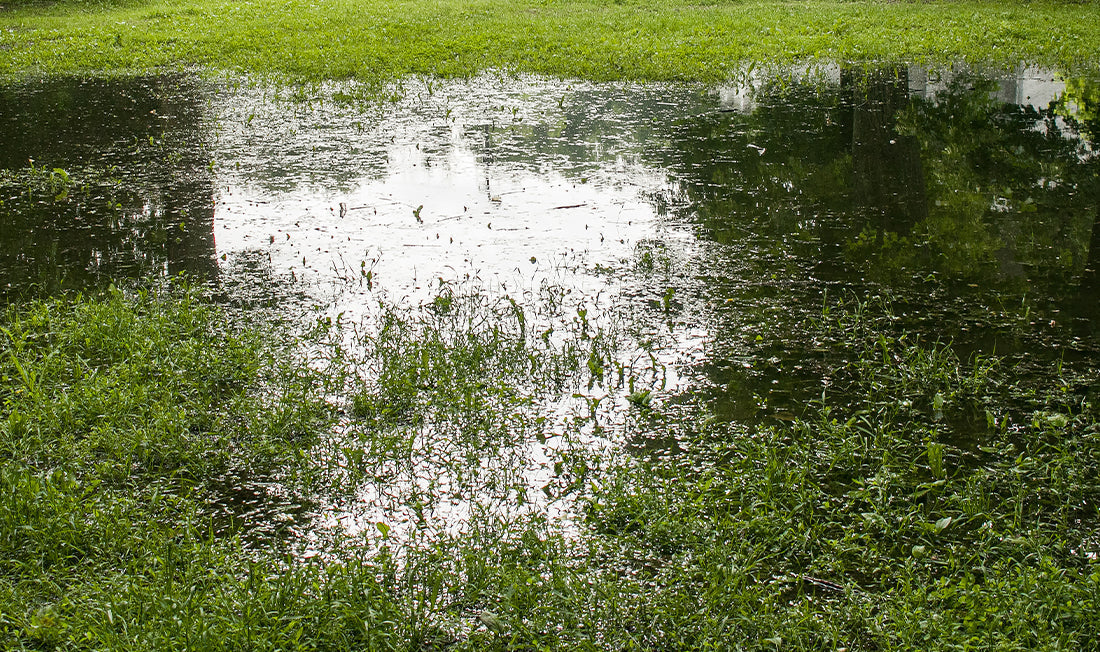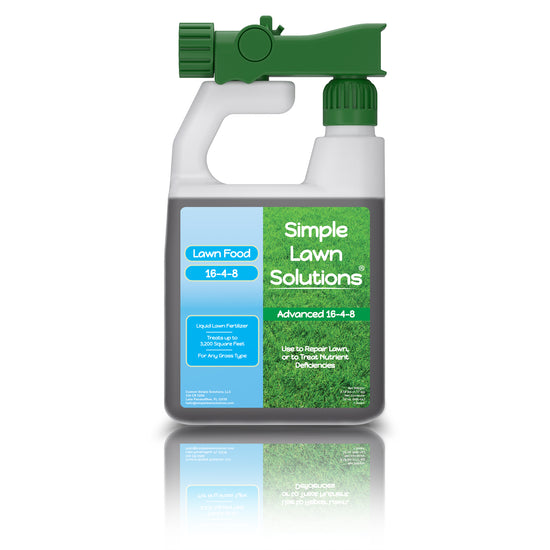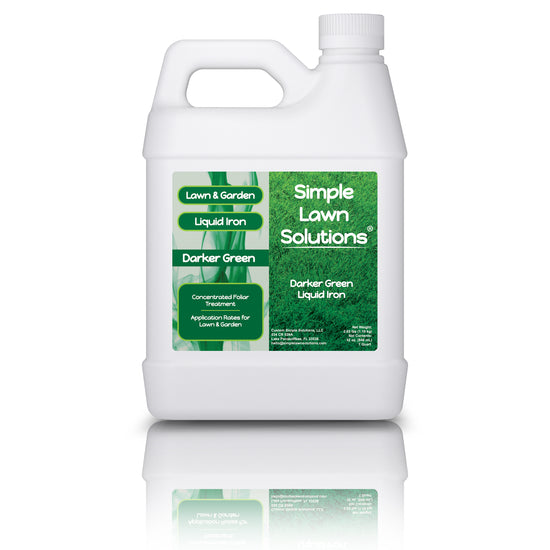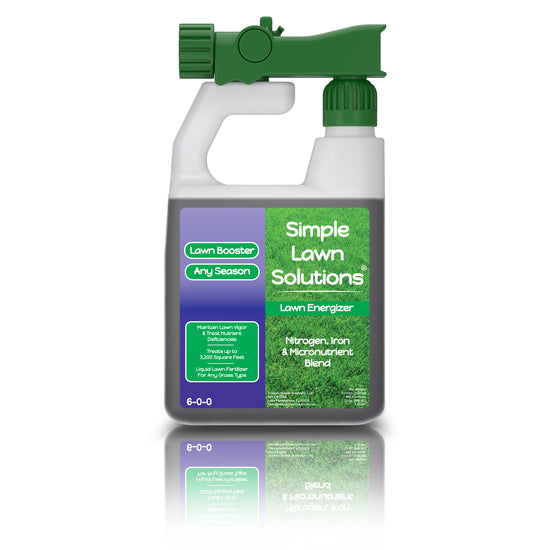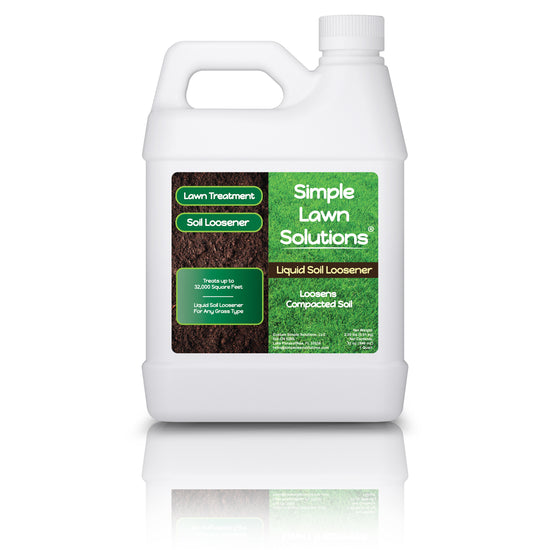Due to the recent hurricane and storm activity, turfgrass was hit with flooding and siltation deposits on many lawns in the affected regions. Repairing a lawn after flooding with silt deposits requires several steps to remove excess silt, relieve soil compaction, and restore healthy turfgrass growth.
How Flooding Hurts your Lawn
Check how much silt has been deposited. Thin layers (less than ½ inch) can often be left to incorporate into the soil, but thicker layers should be removed to prevent suffocating the grass. If water is still pooled, drain it before beginning any repair efforts.
Prolonged flooding reduces oxygen in the soil, which roots need to survive. Root cells can die without adequate oxygen, leading to a decline in overall turf health. Waterlogged conditions encourage harmful pathogens that cause root rot, which weakens or kills the grass. The force of hurricane rains can compact soil, especially on lawns with heavy clay or silt-rich soil. Compacted soil restricts water infiltration, root penetration, and gas exchange, causing stress to the turf. Prolonged water pooling also contributes to compaction, as the weight of the water presses soil particles together.

Flooding often deposits a layer of silt or mud on the lawn, especially from river overflow or run-off. A thick silt layer can suffocate grass by blocking air, water, and light from reaching it. Hurricane flooding can bring debris like leaves, branches, and artificial materials. If not removed, debris can smother grass, leading to bare spots. If the floodwater is brackish or salty (familiar near coasts), salt accumulation can harm grass by drawing moisture out of the roots, leading to dehydration and brown, dead patches. Salt in the soil disrupts soil structure, causing particles to bind tightly, reducing soil permeability and hindering root growth. Sodium can also replace other essential nutrients in the soil, leading to nutrient deficiencies.
Fast-moving floodwaters can wash away the topsoil, particularly in sloped areas. Erosion removes nutrient-rich soil, leaving behind bare patches and making it difficult for grass to regrow. Solid currents or high winds can uproot grass or peel back turf sections, especially in areas with poor root anchoring. Floodwater can carry weed seeds, depositing them on the lawn. Once the water recedes, these seeds can germinate and spread, outcompeting recovering turfgrass. Hurricanes often bring fungal spores and other pathogens that thrive in wet, humid conditions. Common diseases after flooding include Pythium blight, brown patch, and leaf spot, which can quickly spread across waterlogged turf.
Flooding from urban runoff may introduce contaminants like oil, pesticides, and fertilizers, harming turfgrass and soil microorganisms. Occasionally, floodwaters may carry heavy metals or toxins from industrial areas or agricultural fields. These contaminants can affect soil health in the long term, potentially requiring soil remediation.
Saturated soils lead to a lack of oxygen, which can cause chlorosis (yellowing of leaves) as the grass struggles to photosynthesize. Dead patches (necrosis) can occur if turfgrass is submerged too long or roots die from oxygen starvation or disease.
6 Steps to Fix a Flooded Lawn
1. Remove Excess Silt
For layers of silt thicker than ½ inch, gently rake or shovel off as much as possible. Be careful not to damage the existing grass or underlying soil. For a lighter layer of silt, a power broom or strong jet of water can help loosen and wash away deposits without disturbing the soil structure too much.
Use a power broom to sweep it off the grass surface for finer silt layers. If the silt is dry enough, a leaf blower can also help, blowing it off without harming the grass. These tools work best when the soil and silt are somewhat dry to minimize the risk of compaction. For areas with a thin layer of silt, a high-pressure garden hose can help wash away the silt without harming the grass. Start from one end of the affected area and use the water stream to move silt toward a drainage area or off the lawn. Avoid using excessive water that could further saturate the soil.
2. Perform Core Aeration
Once the lawn has dried somewhat, use a core aerator to remove small plugs of soil, which will help reduce compaction caused by the flooding and allow better air and water penetration. If the soil is heavily compacted, consider multiple aeration passes, especially in areas where water and silt accumulation are the worst.
Core aeration is particularly beneficial for flooded lawns with high silt content because it directly addresses soil compaction, poor drainage, and limited oxygen availability, all of which are common problems in silt-heavy soils after flooding. Silt particles are small and easily compacted under pressure, especially after flooding. Compaction prevents air, water, and nutrients from moving freely through the soil, creating an inhospitable environment for roots. Core aeration removes small plugs of soil, relieving compaction and creating space for root expansion and gas exchange.

Silt-heavy soils tend to have poor drainage because the small silt particles can block pore spaces. This worsens after flooding, as excess water pushes silt into tighter formations, reducing the soil’s ability to drain. Core aeration opens channels in the soil, allowing trapped water to move downward and improving drainage. This helps dry out the lawn more quickly and reduces waterlogging. Flooded silt soils lack oxygen, which roots need to thrive. Core aeration increases airflow by creating direct channels to the root zone, allowing oxygen to enter and carbon dioxide to escape. This exchange is essential for root respiration and overall grass health.
Aeration improves oxygen levels in the soil, which helps break down organic matter (like thatch and dead roots) left from flooding. This decomposition process improves soil structure and nutrient availability, especially in silt-heavy soils with poor organic content. Core aeration supports stronger, more profound root growth by relieving compaction, improving oxygenation, and enhancing drainage. Healthy roots are more resilient to stress, allowing the turfgrass to recover better and establish a more robust root system in silt-heavy soils.
In cases where a light layer of silt remains on the lawn, core aeration helps integrate silt into the soil profile, balancing soil texture and improving structure over time. Aeration helps create a loamier, more stable soil mix that better supports turfgrass when combined with organic amendments like compost or sand.
3. Apply Soil Loosener
Simple Lawn Solutions Soil Loosener will aid in flushing the soil after core aeration. It can be beneficial for repairing a flooded lawn by enhancing water infiltration and drainage.
Soil Loosener promotes better water movement by breaking surface tension and allowing water to penetrate more deeply. After a flood, lawns often have poor drainage, with water lingering near the surface. The loosener facilitates drainage by helping water flow through the soil more freely, drying the lawn faster, and preventing further waterlogging. Compacted, waterlogged soil lacks adequate oxygen, which turfgrass roots need to survive and recover.
A well-aerated, loose soil structure supports beneficial microbial activity, essential for breaking down organic matter and converting nutrients into forms accessible to the grass. This is particularly helpful after flooding, as it accelerates the decomposition of any organic debris left by floodwaters and restores nutrient cycling in the soil. By improving soil porosity, Soil Loosener allows roots to access nutrients more efficiently. This can help turfgrass recover faster after a flood, as it can better absorb the essential nutrients needed for rebuilding strength and resilience.
4. Monitor for Weed Growth
Flooding and silt deposits can introduce weed seeds to your lawn. Be vigilant and remove weeds by hand before they are established. After new grass has been established, consider applying a pre-emergent herbicide to prevent weeds from taking over bare areas.

5. Improve Long-Term Drainage to Prevent Flooding
If your lawn is prone to flooding, consider adding French drains, grading adjustments, or other drainage solutions to divert water from the area. Over time, compost or organic matter will improve soil structure, helping prevent silt buildup and reducing compaction. Improving long-term drainage involves strategies to enhance soil structure, prevent water pooling, and improve water movement away from the lawn.
French drains are trenches filled with gravel or rock containing a perforated pipe to direct water away from flood-prone areas. Installing them along low-lying parts or around the perimeter of your lawn can help manage excessive water flow. A dry well, an underground structure filled with gravel or other materials, collects and disperses excess water, making it ideal for areas that experience periodic flooding. A swale is a shallow, sloped trench that redirects water away from your lawn, often leading it to a more suitable drainage area or rain garden to prevent pooling.
6. Limit Foot Traffic on Lawn Until Recovery
Avoid mowing or walking on the lawn until it has started to recover to prevent further compaction and damage to the new grass. Flooded or saturated soil is highly susceptible to compaction, as water fills the soil pores, reducing structural stability. Walking or using equipment on waterlogged soil compresses these particles even more, leading to severe compaction, which restricts air, water, and nutrient movement—essential for turfgrass recovery and root growth.
Compacted, waterlogged soil has limited air (oxygen) and poor drainage, which slows turfgrass recovery. Limiting traffic allows the soil structure to settle naturally as water drains, creating pore spaces that can hold oxygen, which is crucial for turf roots to function and support new growth. Roots are especially vulnerable in flooded conditions, and any extra pressure can damage or tear them. By reducing traffic, you help avoid further harm to the roots, allowing them to focus on re-establishing and spreading. Healthy roots are essential for absorbing water and nutrients, so providing a stress-free environment helps speed up lawn recovery.
Heavy foot or equipment traffic on saturated soil can cause ruts, divots, and uneven patches, which are challenging to repair and cause later issues with mowing and maintenance. Limiting traffic allows the lawn to settle evenly as it dries, making restoring an even, level surface easier afterward. Soil microorganisms, essential for nutrient cycling and organic matter decomposition, struggle to survive in compacted, soggy conditions.
Giving the soil time to dry without traffic disturbance helps these beneficial organisms recover, ultimately supporting healthier soil and turfgrass. Aeration, soil amendments, and reseeding efforts are more effective when the soil is not heavily compacted or disturbed. Keeping traffic off the lawn creates optimal conditions for these recovery methods, resulting in a faster and healthier restoration.
7 Steps to Repair a Flooded Lawn
Repairing a lawn after flooding involves several key steps to restore healthy soil structure, prevent further damage, and encourage turfgrass recovery. Here’s a summary of the most effective approach:
- Remove Standing Water and Debris: Begin by draining any remaining water and clearing debris, silt, or mud left by the flood. Excessive silt layers should be carefully removed to prevent smothering the grass.
- Aerate to Relieve Compaction: Flooded soil is often compacted, restricting air and water flow. Core aeration helps break up compacted areas, improves drainage, and allows roots to access essential oxygen and nutrients.
- Apply Soil Loosener to help the downward movement of water. Organic matter, such as compost, can be top dressed to enhance soil and promote better drainage.
- Overseed and Patch Damaged Areas: For bare or thin patches, overseed with turfgrass suited to the local climate—Topdress with a light layer of soil or compost to protect seeds and promote even growth.
- Limit Traffic on the Lawn: Restrict foot and equipment traffic while the soil dries and recovers. This prevents further compaction and allows roots to reestablish without disturbance.
- Water and Fertilize Appropriately: Water the lawn lightly and consistently to support seed germination and root recovery, but avoid overwatering. Use a balanced fertilizer to encourage vigorous growth once the grass shows signs of recovery.
- Improve Long-term Drainage: To prevent future flooding, consider installing drainage solutions like French drains, regrading, or rain gardens in low-lying areas.
By following these steps, you can effectively restore a flooded lawn, helping turfgrass regain strength, resilience, and an even, healthy appearance.


